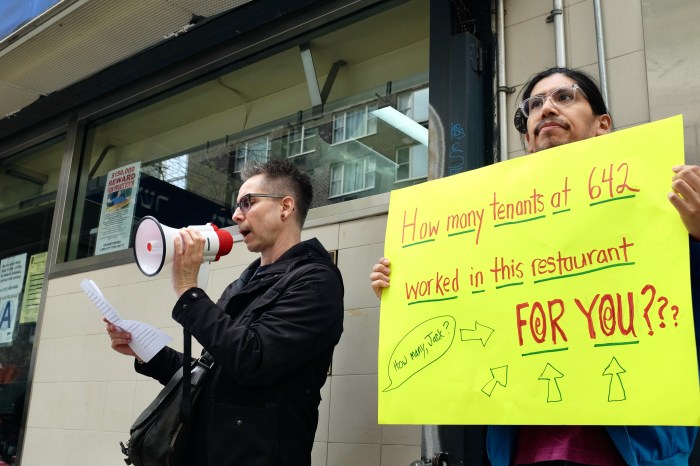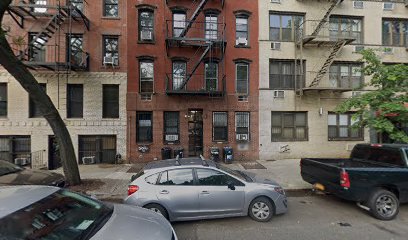BY BONNIE ROSENSTOCK
Camille Billops, Corrine Jennings champion African art
Corrine Jennings came to New York from Rhode Island in the 1970s — armed with the drive and credentials to be a Broadway scenic designer. However, the head of the union told her they didn’t have blacks or women, and they were not going to. “That’s theater,” said Jennings. “This field, the art world, is so terrible for everybody that it didn’t matter what I did because they weren’t going to pay attention anyway,” she recalled laughing.
So in 1979, with her artist husband Joe Overstreet, she established Kenkeleba House at 214 E. 2nd Street to promote minority artists. Kenkeleba (stress on second syllable) is a plant indigenous to West Africa, the Caribbean and South Africa, which is valued for its nutritional and medicinal properties, explained Jennings. “It can grow in a dry area and is spiritual, and the name sounded musical to me.”
Kenkeleba’s high ceilings and open space house large group exhibits and large works — while Wilmer Jennings, which they opened in 1991 across the street at number 219, has four discrete galleries and is optimal for solo shows and works on paper. It is here that director Jennings is presenting painter-sculptor Camille Billops’ aptly named “Fabulous Fables and Legendary Exploits, Camille Billops in Retrospect on Paper.” The 63 works represent a fraction of Billops’ creative output from the 1960s to the present. The flamboyant Billops and the low-key Jennings have known each other for over 30 years.
Billops’ work is biographical and often intertwined with social realism — “now encased in a mythological structure,” Billops said. “It’s always been about social issues and multi-culturalism although some works are purely decorative. I use everything that I remember as a child; my travels, my position on race. My husband is white, which many people say is the slave master. A lot of people who had a problem with it were married to white women. Now it’s mellowed out,” she observed.
The arc of her relationship with her husband, theater historian/writer/filmmaker James V. Hatch, figure prominently in the “Love in the Middle East” series from the 1960s, and the China series from the 1980s. Billops, 76, and Hatch, 81, have been together for fifty years and married for twenty. The “Dancer Collage” series from 2007 celebrates transcendent moments, represented by the highly stylized and gravity-resistant dancer/lovers. “They serve as symbols of the artist and her husband, whether bearded or with horns or capes, as well as my parents as they escape the laws of gravity and social boundaries,” Billops explained.
A half dozen of their collaborative films — screened on Saturdays, also relate to her life and family while examining social issues (such as the sardonic “The KKK Ain’t Just Rednecks,” in which a multi-cultural group of her friends discuss race). The achingly poignant “Finding Christa” is about Billops’ decision to give up her four-year-old daughter for adoption — and the young woman’s search to find her. In 1992, it tied for the Sundance Grand Jury Prize for best documentary.
Billops and Hatch reside and work in their loft at 491 Broadway in SoHo — which they bought sight unseen from playwright/director Richard Foreman in 1975 for $11,000. That year they embarked on the groundbreaking Hatch-Billops Collection — which has burgeoned into an extensive archive and major research resource on the cultural life of more than 1,200 African-American writers, performers and visual artists — “and white artists when they have a direct relationship with black people,” she said. It consists of recorded and reel-to-reel oral histories and the numerous volumes of books they produced based on them — scripts, books, periodicals, posters, pamphlets, photographs, theater programs and other significant material. This past October, Billops and Hatch were named Notable New Yorkers and inducted into the City Lore 2009 People’s Hall of Fame for their extraordinary work.
Jennings, too, is a chronicler and collector. When people asked her why, as a black woman, she moved to the Lower East Side, she could point to the extensive research she has done on the history of the neighborhood and its African roots from the days of slavery and just after. African Free School #6 was on Columbia Street, there were settlements on Avenues B and C; and the first community of black freedmen lived on the Bowery.
Jennings and Overstreet own both buildings, which they bought back when no one wanted to live there. When they did free programs for neighborhood children — many of whom couldn’t write their names. She had to walk them home because of the rampant crime and drug dealing. “We stopped doing them when I had to hire a guard to keep the dope out. The dealers gave them the drugs to hold,” she recalled.
The two spaces are non-profit and get some support from the New York State Council on the Arts, the Department of Cultural Affairs and small family foundations. “We couldn’t have existed as a commercial gallery,” she said. “It took fifteen years before we sold anything, and we are still pleasantly surprised when something sells.”
As a pioneer in multi-cultural programming, Jennings estimates that over the years she has shown more than 5,000 African-American, Afro-Caribbean, Latino, Native American, Asian-American and some white artists, produced twenty-three catalogues and organized a few touring exhibits to Africa. Plans for 2010 include a show of artists from the Virgin Islands. “We know how to put things in suitcases,” she said, referring to the exorbitant expense of shipping works to the U.S.
She also hopes to create her dream museum at Kenkeleba. She possesses a large collection of African-American art that reaches back to the 19th century. “All those years, when no one would buy artwork that cost around $200, if we weren’t renovating some buildings in the neighborhood and could afford it, we bought it,” said Jennings.
“I think to some extent things have improved for black artists from the time when we wanted to create a place for an audience of peers,” she continued, “but most don’t have a place to show their works. Also, they may need support over a lifetime because for some it takes a long time to develop. It’s difficult for all artists in a society like this that sees success in a different way that most artists view it; but the problems are exacerbated for black artists.”
Billops added, “If you can access alternative means, you can do what you want to do. If you stand in line behind the linekeeper, which a lot of us did in the 70s, you were rewarded by a few things they threw at you. By the time they let you through, you would be on a walker. Instead of fighting the Whitney, you should have bought one of those cheap buildings,” she asserted.
Billops was one of several women Collette Fournier photographed around 2002 through a project she was working on about African-American women in the arts (while attending graduate school at the Vermont College of Fine Arts).
Fournier is a member of Kamoinge, a collective of approximately twenty-five black photographers, whose group show, “Kamoinge: In the Moment,” will be at Calumet, 22 West 22nd Street, during the month of February. Kamoinge (which means “a group of people working together” in Kikuya, an East African language) was established in New York in 1963 to address the under-representation of black photographers in the art world. Their works include images of daily life in black America spanning the last half of the twentieth century.
Fournier has been campus photographer and adjunct photography professor at SUNY Rockland Community College since 1992. She is working on a book weaving photography and memoir — which begins with her grandparents and includes people she has photographed through her creative and personal journey. At Calumet she will be exhibiting five color photographs from her 2007 trip to Ghana, Togo and Benin. “I try to work within a body of work or series — like my black family series, dance series or light and form,” she explained. “They reflect my activism, in social and political causes on a grassroots level.”
Kamoinge opened up a lot of doors and gives her a chance to look at other photographers’ work where they have a connection culturally. “I think it’s important not to limit yourself, but certainly to pay homage to your roots,” she said.
Fornier, who is in her mid-50s, came of age during the civil rights and hippie eras, “the two cultural influences making me into a full person,” she said. Her father, a portrait artist — and her mother, a clothing designer — provided creative support and set up a darkroom for her. Therefore, on college night at her high school in Queens, when a secretary tried to discourage her from going into photography, Fornier blew up at her. “Fortunately I had read Malcolm X, Elijah Mohammed, Dick Gregory, Maya Angelou, Toni Morrison. So many said the same things; that they were discouraged from becoming what they wanted to become. I was taught not to be disrespectful, but my mother understood. I think she never got as far as she wanted to get.”
Some things have changed, said Fournier, who is a generation or two younger than Jennings and Billops, “but I can still count a handful of faculty of color at SUNY, and it’s been like that since I started here.”

















